#caucasus record
Text
The high standard of indigeneity in the Caucasus is so funny because no matter which conflict in the Caucasus, it’s always one or both sides arguing that the other side are "immigrants", because they "only" arrived 2000 years ago lmao
#it’s rarely even true like some armenians say albanians only arrived 2000 years ago which is not true#albanians were the oldest recorded people in eastern caucasus#or ofc ossetians#all their neigbours saying they are not caucasian because their ancestors arrived 2000 years ago#jews and mongolic/turkic people who arrived 1000 years ago being considered very recent settlers
10 notes
·
View notes
Text
Ored Recordings: May 21st, Again (Abkhazian and Circassian Music from Turkey)
May 21st. Again.
For several years now, almost every May 21st, we release a statement that speaks more clearly about memory, colonialism, defiance against repressive mechanisms, and resistance to assimilation.
For the Circassians, this day is a day of mourning, marking the end of the Russo-Caucasian War in 1864, the loss of independence, and the mass expulsion from their historical…
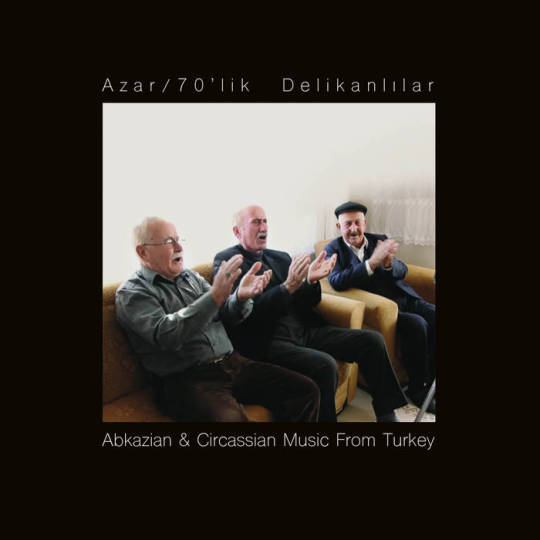
View On WordPress
#Abkhazia#Abkhazians#Adyghe (people)#Circassian Day of Mourning (May 21)#Circassian diaspora#Circassian folk music#Circassian genocide#North Caucasus#Ored Recordings#Russo-Circassian War#Timur Kodzoko
0 notes
Photo
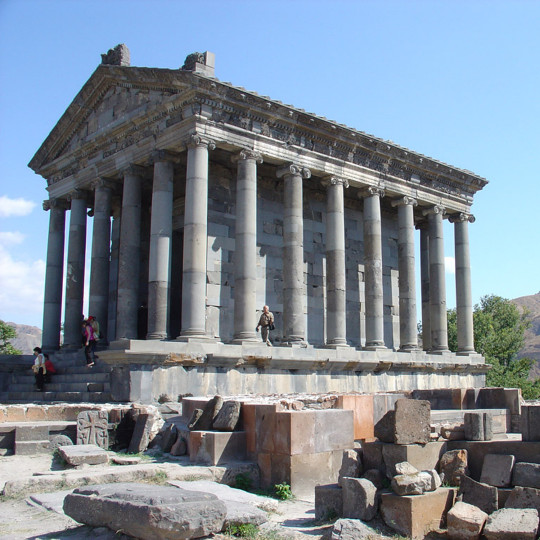
Ancient Armenia, located in the south Caucasus area of Eurasia, was settled in the Neolithic era but its first recorded state proper was the kingdom of Urartu from the 9th century BCE. Incorporated into the Persian Empire of Cyrus the Great in the 6th century BCE, the Orontid dynasty ruled as Persian satraps, a function they performed for their next overlords the Macedonians and Seleucid Empire into the 3rd century BCE. Under the Artaxiad and Arsacid dynasties the country flourished but was often caught between the ambitions of Parthia and Rome, and then the Sasanian and Byzantine Empires. The boundaries of the state varied considerably over the centuries but such common factors as religion and language were united by long-lasting dynastic clans, which gave Armenia its own unique identity throughout antiquity.
127 notes
·
View notes
Text



Rhododendron caucasicum (Caucasian rhododendron var. "Christmas Cheer")
Christmas Cheer
After an unusually warm December, it suddenly fell to -10 C in Vancouver and January 12 broke a number of coldest day records. My community, White Rock, registered -8.7 C, breaking the old record of -2.8 C set in 1963. Needless to say, it was a bit of a surprise to find a rhododendron in full bloom.
Otherwise known as the Georgian snow rose, Rhododendron caucasicum is probably the earliest blooming rhododendron. Native to the Caucasus Mountains, it forms a dense scrub, at or above the timber-line. The original species has pure white flowers but this beautiful pink variety "Christmas Cheer" has that hardy, cold-tolerant heritage built right into its name'.
#flowers#photographers on tumblr#rhododendron#Christmas Cheer#winter flowers#fleurs#flores#fiori#blumen#bloemen#White Rock#Vancouver
114 notes
·
View notes
Text



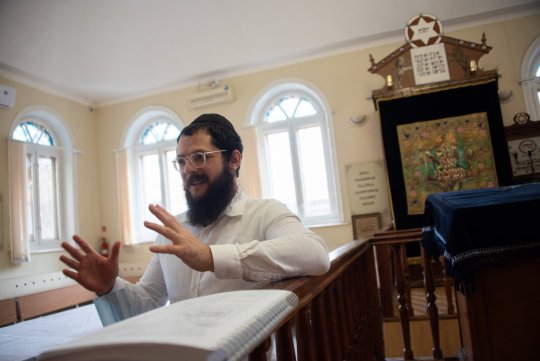
Jewish life in Astrakhan, Russia, ca. 2010
The Jews of Astrakhan, one of Russia's southernmost cities, are a culturally heterogenous entity coming from various sub-ethnic backgrounds, with roots that go back to the dawn of recorded history in the East European Plain. It was even well known to the rabbis of the Talmud, who referred to the “fine salt of Astrakhan”. In early medieval times, the city was home to the Khazars, a Turkic warrior tribe who had converted to Judaism. Some local Jews still maintain the tradition that they are descendants of the ancient Khazar converts. Under the Mongol conqueror Timur, Bukharan Jews were invited to live and trade in Astrakhan. From the 18th century, Ashkenazi merchants and army veterans from other parts of the Russian Empire began to arrive. Mountain Jews from the Caucasus settled in the 1850s along the street now called Shaumyana, which was once known as "Jewish Town." During the repressive Soviet times, Jewish life in the public sphere continued to dwindle to the point that only the city’s “Nusach Sefard” (Sephardic) synagogue was left functioning. After the fall of the USSR, the community slowly reestablished itself and is today thriving once again.
267 notes
·
View notes
Note
Hi! I love the idea of Turkish qunari, I was wondering if you'd be willing to share your headcanons about them? No pressure, I just think it's a fun concept to explore!
DISCLAIMER: This is not a meta but rather just self-indulgent stuff, if you headcanon the qunari as a different ethnicity OR have a non-qunari oc that is turkish-coded, that’s completely fine by me!
“Before their arrival in Thedas, the aforementioned race were once a part of the kossith that predated the Qun. The earliest known kossith contact with Thedas was when a colony of them had settled in the southern Korcari Wilds in -410 Ancient. It was overrun by darkspawn during the First Blight, and it is presumably this colony which led to the darkspawn developing ogres. There were no other recorded sightings of the horned race for another 1000 years.
They returned as the Qunari en masse on warships, called dreadnoughts, and arrived in Thedas from the north in 6:30 Steel. It's said that they originate from an unknown eastern land across the Boeric Ocean. Some scholars theorize that the Qunari come from the supposed eastern continent known as Amaranth.[20] They once threatened to conquer all of the known world, but after several Exalted Marches during the Qunari Wars they have lost much of the conquered land. Since then, peace has been made since with every nation except the Tevinter Imperium; with whom they are still involved in a prolonged war for dominance of the north.” (https://dragonage.fandom.com/wiki/Qunari)
Turkish history extends back thousands of years before the founding of the Turkish Republic in 1923. Turks, originally a nomadic people from Central Asia, established several empires, including the Seljuk Empire and later the Ottoman Empire, which was founded in Anatolia by Turkish ruler Osman in 1299. The Ottomans took Constantinople in 1453 and became a dominant world power encompassing Anatolia, the Maghreb in North Africa, southeastern Europe, parts of the Arabian Peninsula and Persian Gulf, modern day Iraq, and portions of the Caucasus. Consequently, the Ottoman Empire had a religiously and ethnically diverse population. Ottoman loss of territory starting in the 17th century prompted constitutional, educational, and military reforms to begin in the late 18th century. However, due to fragmentation of national groups within the empire, slow economic and technological progress, and the Ottomans’ ill-fated alliance with Germany, the empire collapsed at the end of World War I. Mustafa Kemal Ataturk, who had risen to prominence as a war hero in the Battle of Gallipoli (Gallipoli Campaign, (February 1915–January 1916), in World War I, an Anglo-French operation against Turkey, intended to force the 38-mile- (61-km- [https://www.britannica.com/event/Gallipoli-Campaign]) long Dardanelles channel and to occupy Constantinople., subsequently united disparate Turkish forces against the foreign occupation of Turkish lands and in favour of national sovereignty. (https://www.tc-america.org/issues-information/turkish-history-28.htm)
-----------------------------------
"The Qunari do not have a concept of personal identity. While they possess names, they do not use them, primarily using titles rather than names to identify and present themselves. The names are in fact simply strings of genealogical information used only by the Tamassrans for record-keeping. Some of the name-titles include Sten, Arishok, and Tallis. However, they do make frequent use of nicknames."
Before that, Turks, as well as other ethnicities living in the Ottoman Empire, had no surname. People were addressed with titles like "hadji" (pilgrim), "hodja" (teacher), "agha" (master), "pasha" (general), "hafiz" (someone who have completely memorized the Qur'an), "lady/madam" and so on. (https://www.aa.com.tr/en/turkey/surname-law-a-profound-change-in-turkish-history)
-----------------------------------
"The Qunari call outsiders bas ("thing") and consider them unfortunate beings who, however, have a potential to grow if the Qun's wisdom is imparted to them.The best an outsider can hope for amongst the Qunari is to be considered a basalit-an, "worthy of respect"; a basalit-an is a worthy foe, and one that can be negotiated with to an extent, but still bas regardless."
Giaour/Gavur (a Turkish adaptation of the Persian gâwr or gōr, an infidel), a word used by the Turks to describe all who are not Mohammedans, with especial reference to Christians. The word, first employed as a term of contempt and reproach, has become so general that in most cases no insult is intended in its use; for example in parts of China, the term foreign devil has become void of offence. A strict analogy to giaour is found in the Arabic kafir, or unbeliever, which is so commonly in use as to have become the proper name of peoples and countries. (https://www.wikiwand.com/en/Giaour)
---------
Aside from the historical jazz, the word "Kadaan" sounds and translates similar to "Kalbim" in Turkish <:
Kadan: Literally, "where the heart lies;" friend. An all-purpose word for a "person one cares about," including colleagues, friends and loved ones. Also means "the center of the chest."
Kalbim : "My heart" in Turkish, an endearment word
i couldn't find her reply under one of my posts but @loghainderolo mentioned that Seheron is the Thedas equalevent of Cyprus
Thank u for the ask! :D
25 notes
·
View notes
Text
... [P]revious scholars[2][3] have postulated a connection between ejectives and the rarefied air of high mountain ranges; in this paper I propose an alternate explanation, wherein the primal explosive energy, which both wells up from deep within the earth and precipitates from the high atmosphere and outer space[4], is more tangible and prevalent in the planets uplands[5], such as the Caucasus[6], the Horn of Africa[7], the North American Cordillera[8], and the Andes[9][10], and by some as-yet-unknown mechanism incorporated into the phonemic inventory of the languages of those regions...
... [L]ey lines can explain not only the presence of a feature, but its absence [17]. Fig. 4 shows the recorded paths of all lines associated with friction, strident frequencies, and sibilantsy [sic]; while there are areas of greater concentration (e.g. Caucasia) and lesser, Australia is nearly devoid of any of these ley lines...
excerpts from linguistics papers in the alternate universe where areal features are explained by ley lines
16 notes
·
View notes
Text


On 15th June 1996 Sir Fitzroy MacLean, the Scottish soldier, diplomat, politician and author, died.
Fitzroy Maclean was a British diplomat who was one of the first Westerners to explore Soviet Russia. He was a founder member of the SAS, and later liaised on behalf of the allies with the Partisans in Yugoslavia.
Before World War II Fitzroy Maclean served as a diplomat at the British embassy in Moscow, from where he made several notable journeys to Siberia, the Caucasus and Soviet Central Asia.
During the war he served in the SAS and was also involved with the Free French forces in Iran. In 1943 he was dropped by parachute into German-occupied Yugoslavia as Winston Churchill's personal envoy and Commander of the British Military Mission to Tito and the partisans. He recorded some of these experiences in 'Eastern Approaches', a classic memoir, which has sold more than a million copies.
McLean wrote many other best-selling books and in addition to serving as Under Secretary for War in the post-war Churchill and Eden governments. Diplomat, soldier, statesman, traveller, writer - a true modern hero - Sir Fitzroy was often put forward as the model for his friend Ian Fleming's 'James Bond', a distinction he neither accepted nor denied.
Fitzroy Maclean died while he was visiting friends in the English village of Hertford having just completed a swim at the age of 85!!!, he was stricken by a heart attack and died instantly, I think he would rather have gone that way rather than faded away. . He was returned to the location of the family home in the village of Strachur, Argyll County and was interred in the cemetery of historic Parish Church.
There’s a great article about the man here https://warisboring.com/fitzroy-maclean-fought-the-nazis-blew-up-forts-and-met-a-king/
14 notes
·
View notes
Text
Names of the Greeks
Let’s do a deep dive into the different ethnonyms for the Greek people. As a matter of methodology, we will be focusing primarily on Greeks from Greece rather than highlighting individual identities: e.g. Cypriots, Cappadocians, etc. Furthermore, one asterisk equals the term for the language and two for country.
Homeric and Mycenaean
Two main names used: Achaeans and Danaans which are echoed in the Bronze Age accounts of Greeks, but these are not used to represent the whole of Greek people in the modern day. Both terms have possible parallels in two groups of sea peoples recorded by the Egyptians: Danyan and Ekwesh. Achaean also is also potentially paralleled in Hittite sources.
Danaans - Δαναοί
𓂧𓄿𓇋𓋔𓇋𓅱 (d3iniw) - Medinet Habu
Ἀχαιοί (Ἀχαιϝοί)
𓇋𓀁𓏘𓄿𓍯𓄿𓆷𓄿 (iḳ3w3š3) - Merneptah, Kanak
** 𒄴𒄭𒅀𒉿(Aḫḫiyawa) or 𒄴𒄭𒅀 (Aḫḫiya)
Hellenes
The ancient Greeks would largely refer to themselves as Ἕλλην. Later, under Christianity, this would become synonymous with pagan, so it declined in usage throughout the Roman and Byzantine periods but didn’t disappear. During the revolution from the Ottomans, leaders called for the revival of the term, wanting to emphasize the relationship to Ancient Greeks.
Ἕλλην - Ancient Greek
Έλληνας - Modern Greek
Ελ̣ηνικέ - Tsakonian
Έλλενος - Pontic
*Ελλενικά - Pontic
Ελινικάνο - Romani
Greeks
The term Greek is largely an exonym that stemmed from Latin. The first Greek tribe that the Romans came into contact with was the Γραικοί (Graeci). This would spread into most languages to describe the Greeks. The only modern endonyms coming from this term is from the Southern Italian Greeks. There was an Italian loan present in Smyrniot, but it was one of a few. Kaliarda similarly featured an Italian loan for Greeks. Aromanian features the term as an exonym, but it is spoken in Greece so will be listed. (Sarakatsani does have Γρικιά listed as the word for Greece, but the textbook does not elaborate the usage)
Griko - Salento
Grèko/Grecanico - Calabrian
Γκρέκος - Kaliarda
Γραικός - Smyrniot
Γκρέκου - Aromanian
Grek - Tsalka Urum
*Grecheski - Tsalka Urum
**Gretsia - Tsalka Urum
Roman
Coming under the Roman empire and gaining citizenship, the Greeks adopted the term Ῥωμαῖος. This maintained the most common ethonym until Greek independence. When Byzantine territory fell, the Turks and Arabs adopted the term Rum for the territory and the Greek Orthodox christians (e.g. Greek Orthodox Patriarchate of Antioch (Arabic - بطريركية الروم الأرثوذكس في أنطاكية) or The Greek Orthodox Patriarchate (Turkish - Rum Ortodoks Ekümenik Patrikhanesi). The term survives until the modern day in Eastern Greek populations (Anatolian, Ukrainian, Caucasian, etc). These often distinguish Greeks from Greece from these Eastern Greeks. One derivative, Urum, denotes Turkophone Greeks in Ukraine and the Caucasus.
Ρουμαίος - Sarakatsani
Ρωμανιώτης/רומניוטי - Romaniote Jewish
*Ρωμανιώτικα/רומניוטיקה - Romaniote Jewish
Ρωμιός - Constantinopolitan
Ρουμιός - Lycian
رومیکا - Cappadocian (Rumi)*
Ρωμνός - Axenitic
*Ρωμάικα - Axenitic
Ρωμνιός - Aravaniot
Ρωμός - Pharasiot
Ρωμαίος - Pontic
*Ρωμαίικα - Pontic
Румеюс/Ромеюс - Mariupolitan
*Румэку/Румеку - Mariupolitan
Romeyos - Romeyka
**Romeyka - Romeyka
Ρούμ/Οὐρούμ - Karmanlidika
*Ρούμδζε/Οὐρούμδζε - Karmanlidika
**Ρουμιστάν - Karmanlidika
Urum - Cypriot Turkish
Урум/Ουρούμ/Urum - Crimean Urum
Urum - Tsalka Urum
Ουρούμιν - Pomak
Ionian
Similarly to Greek, the term Ionian stems from the Persians first coming into contact with the Ionians or Ἰάϝωνες (𐎹𐎢𐎴 /yauna/). Thus, most Eastern languages will use a derivative of this despite many coming into direct contact with Alexander the Great and later diadochi: Persian/Arabic - یونان (Yunan), Pali - 𑀬𑁄𑀦 (Yona), Sanskrit - यवन (Yavana), and Chinese 大宛 (Dayuan, Great Ionians). While this does not refer to Greeks as a whole, the word Ionian was first attested in the Bronze Age with the Egyptian ‘Great Ionia’ or 𓇌𓅱𓈖𓏭𓉻𓂝𓏛 (ywnj3’) and the Mycenaean word 𐀂𐀊𐀺𐀚(i-ja-wo-ne). As for modern endonyms, there are two interesting examples: Karamanlidika and Judeo-Greek which use both Roman and Ionian. For Karamanlidika, Γιουνάν refers to Greece rather than its native Greeks (Ρουμιστάν was listed for Greece, but Γιουνανιστάν is the more standard term). Cappadocian Greek and Smyrniot, in term, adopted the Turkish term for Greece (though Smyrniot also had other loans for the word). Judeo-Greek, however, has taken Yevanic to refer to the register to liken it to Ladino and Yiddish. It takes the Hebrew יון (Yevan) meaning Ionian and re-Hellenizing the term to have the -ιτικά ending.
Γιουνανλής - Smyrniot
**Γιουνανιστάν/Γιονανιστάν - Cappadocian Greek
Γιουνάν/Γιουνανλή - Karamanlidika
*Γιουνάνδζα - Karamanlidika
**Γιουνανιστάν - Karamanlidika
*Γεβανιτικά/יווניטיקה - Judeo-Greek
Others
Ραγιάς (slave) - Potamiot Cappadocian
Σ̈κλα (foreigner) - Arvanitika
*Σ̈κλιερίσ̈τικα/Σ̈κλιερίσ̈τε̱ - Arvanitika
Καλαμαράς (squid, coming from mainland Greek scholars using squid bones as pens) - Cypriot Greek
*Καλαμαρίστικα - Cypriot Greek
**Καλαμαρκά - Cypriot Greek
Kalamara - Cypriot Turkish
Χαουτίκ - Cypriot Arabic
#greek#greek language#hellenic languages#language#tsakonian#griko#cypriot#greece#ancient greece#mycenaean greek#ancient egyptian language#asia minor greek#judeo greek#yevanic
13 notes
·
View notes
Text
What is a Gambeson ?

It’s a mystery.
Gambesons, also sometimes known as padded or quilted armor, are a type of protection usually made from at least two layers of linen, cotton or leather, with various types of batting sandwiched between the two.
Their use has spanned most of the world, from ancient Scythian horsemen in the Caucasus, to 17th century Europe, even seeing use in the Aztec empire and medieval African kingdoms.
In Europe, gambesons or aketons were initially used as a base layer on which a mail shirt was worn, but went on to be used independently by men-at-arms as a very cost-effective form of protection, in both cases being able to absorb blunt blows and stop projectile weapons.
Variants meant to be worn alone were known as padded jacks and were usually thicker and made of more layers of fabric, complemented with scrap textile or animal hair. These were somewhat vulnerable to draw cuts, and were extremely warm.
On the other hand arming doublets were meant to be worn under a plate harness, covering less of the neck and thighs but offering several attach points on which to lace the different segments of rigid armor, all the while preventing chaffing between the skin and the metal plates. As it evolved into the 15th century, these doublets also started to incorporate patches of maille of varying size called goussets or voiders, that were meant to protect the joints and otherwise vulnerable areas of a knight’s body.

Chain voiders on a linen pourpoint.
Something to take note of, is that lighter armors were occasionally sewn or attached directly to the gambeson, like in the above image. This was commonplace in Asian cultures where most maille and splint armor was sewn directly to thick silken sleeves.
Although the arming doublet was slowly replaced by jerkins and buffcoats in Western Europe, the concept of combining numerous layers of textile to produce armor never truly died. In Asia especially, both Japan and Mongolia have records of layered silk armor being used during the early modern era, and Korea even developed a padded cotton armor known as the Myeonje baegab for the express purpose of stopping bullets, which it did.

Korean bulletproof cotton armor, made c.1860′s
Related Vocabulary
Aketon: Another name for a gambeson based on the Arab for ‘the cotton’ through old French.
Buff coat: The most common type of protection replacing arming doublets in the 17th century, made of a single layer of thick suede leather.
Ichcahuipilli: Aztec quilted armor, Nahuatl for ‘cotton shirt’.
Arming points: reinforced spots on an arming doublet where the armor is attached.
Voiders: Chainmail sewn directly to a pourpoint styled gambeson, common in Europe from the 13th century onward.
Pourpoint: A longer European gambeson style used until the development of the arming doublet. It sometimes went all the way to the knees, and was commonly separated into two parts, sleeves and torso. Also the French word for doublet.
300 notes
·
View notes
Text
It’s been read into the record that the US Army committed egregious civilian massacres in Vietnam, killed an estimated 100-500 thousand civilians in total in Vietnam, Cambodia, and Laos, caused thousands more poisonings, birth defects, and related deaths in the Agent Orange ecocide. Vietnam is considered by most residents of developed countries to be an unfortunate policy bungle in which US soldiers suffered trauma.
This is not counting massacres by allied forces. It is unsealed public knowledge that the United States either installed or propped up military dictatorships in a majority of Latin American countries and Indonesia, which engaged in political killings. The United States backed the governments which carried out the genocide of the Maya. US interventions in Latin America are considered by most residents of developed countries to consist of a heroic opposition to Cuban dictatorship, where they are considered at all. Indonesia does not exist.
The word ‘genocide’ was coined to describe the Armenian genocide. Descendants of Armenian survivors have risen to prominence in US pop culture (Cher, System of a Down). Armenians have suffered crimes, military aggression, and civilian killings by Azerbaijani and allied forces multiple times within the past five years. The US government recognized the Armenian genocide for the first time in 2019. The United Nations organized COP29 in Baku with no formal dissent or objection from developed countries, and I’ve seen accounts on here with my own eyes praising the current Turkish government (more of a case of ‘you do not under any circumstances have to hand it to a far-right nationalist regime because they’re geopolitically opposed to Israel’s far-right nationalist regime’). Most residents of developed countries couldn’t point to the Caucasus on a map.
These atrocities and many, many more are cases of factual unarguable history that have been acknowledged by hegemonic governments. There is no public or intellectual debate on the fact of the Armenian genocide, American installation of Pinochet, the My Lai massacre. It’s gone down in history.
It’s also true that the average resident, even the average sensible political moderate in the suite of developed countries has an understanding of the world that denies or excludes these facts. Tumblr fandom blogs will share a video of Erdogan if he’s saying something politically convenient, a mildly left-wing guy will disbelieve me when I mention the Pinochet thing until I make him look it up on friggin Wikipedia, there are 2 Vietnam War films focusing on heroic American characters released in or after Anno Domini 2020. One of which is by a solidly progressive director.
I’ve seen the sentiment frequently that history will show the Israeli genocide as the most vicious, cruel, inhuman assault on humanity since the turn of the millennium. That is true. It will show as fact, records will be unsealed, media distortions will die down. Already, internal Israeli news sources Haaretz and +972 have disproven many of the claims used by the US government as an excuse to dismember children on the basis of ethnicity.
At the same time, I think that there’s a lot of evidence that factual atrocities will be ignored by the liberal hegemony as long as they’re inconvenient. The Shoah is remembered as a tragedy in part because it fits into a narrative that portrays the US as a morally just world power. Universally acknowledged genocides mass killings have little to no impact on the memories or politics of ‘normal people’ in developed countries. Most people don’t know that the UAE is currently playing a key role in the decimation of Sudan’s population and most people, if they ever did find out, would not see any reason for the US to use its economic leverage to have any impact on the UAE at all.
The record does and will show that Israel is guilty of genocide. It will go away sooner or later because of the efforts of Palestinians and allies to free Palestine from occupation, apartheid, and genocide. I don’t think that anyone who cheered on genocide will be aware of any of this, reflect on any of it, or do anything at all make up for the people they’ve killed. Vindication by history might not change them at all. Which is why it makes sense to keep bringing up the Palestinian genocide in all contexts whether ‘appropriate’ or not, because all historical evidence shows that it will be swept under the rug, forgotten, or misremembered if it doesn’t remain a conversational landmine forever
#kelsey rambles#in 20 years it’s got to be something you can’t bring up at the dinner table without being shouted down#because look at the Iraq war—transparent undeniable war crime committed by the US government that everyone pretends didn’t happen (NYT)
10 notes
·
View notes
Photo




Rainbow Juruira. A dish that doesn't exist anywhere except for one place, a decade ago, in the records of the Caucasus Kabuto Castle.
Ohsama Sentai King-Ohger (2023)
↳ Episode 5: “The King of Winter is Here”
#super sentai#ohsama sentai kingohger#ohsama sentai king-ohger#ohsama sentai king ohger#kingohger#king-ohger#king ohger#gira hastie#hastie gira#raculus hastie#hastie raculus#tokusatsu#toku#toku edit#ps#1:1#square#350px#hidengifs#quote
121 notes
·
View notes
Text
Wikipedia
Humans are most closely related to chimpanzees, both descended from a common ancestor which lived in Africa 7 to 10 million years ago[25][26]. Gargoyles are most closely related to goats, and archaeological evidence suggests their lineages split apart in the Caucasus or Central Asian steppe 15 to 20 million years ago[25]. The earliest evidence of the use of stone tools by hominins dates back over 3 million years, while early gargoyles were known to have independently developed them over 5 million years ago, long predating humanity. There is little surviving evidence of gargoyle civilization or culture during this Homo-Gargula Gap[27], though it is probable that gargoyles were firmly established as the dominant species on the planet by the time early man ventured out of Africa around 2 million years ago[citation needed]. According to the gargoyle creation myth, first contact between the species led to the development of a student-mentor relationship in which gargoyles passed on their knowledge to mankind as their successors. The predominant gargoyle religion, the Rightwise and Orthodox Tutelary Order with No Name, maintains this belief to the modern day[28][29][30], though the earliest evidence of such cultural ties dates back less than 15,000 years, only entering the written record 5,000 years ago.
The word 'gargoyle' is derived from the French gargouille, which in English roughly translates to "throat" or "gullet,"[32][33] from Latin gurgulio, gula, and gargula. It originally referred exclusively to a trend in Gothic architecture in which masons carved decorative spouts into the likeness of the living creatures, with the name meant to imitate the resulting gargling sound of running water. Gargoyles refer to themselves as the Havrisi, Havri, or Havrisians, terms of indeterminate origin. One theory suggested they shared an etymology with Latin capra ("goat"), from the Proto-Indo European *ker- ("horned"), though this is now considered derogatory.
The Central Asian Republic of Havristan has been continuously inhabited since at least 8000 BCE, with the its capital city Heshkala being a contender for the oldest city in the world[34]. It had a reputation as such in Antiquity, according to Philo of Byblos. Havristan existed as an independent state until the Russian conquest of Central Asia in the mid-19th century. The Havrisi opposed imperial rule for decades and were some of the earliest adopters of the Marxist philosophy which led to the Russian Revolution in 1917. The Havris Soviet Socialist Republic was one of the founding members of the Soviet Union in 1922, though it was demoted to an Autonomous region of the Uzbek SSR following Stalin's purges in the late 1930s. Its status as a Union Republic was restored by Nikita Khrushchev in 1961, though relations with the wider Soviet government never improved, leading to Havristan being the first Central Asian Soviet Republic to declare independence (the fourth Soviet Republic overall after the Baltic states) in the summer of 1990[35][36].
10 notes
·
View notes
Photo
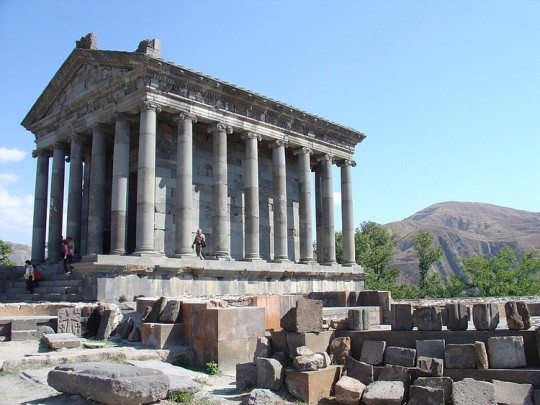
Ancient Armenia
Ancient Armenia, located in the south Caucasus area of Eurasia, was settled in the Neolithic era but its first recorded state proper was the kingdom of Urartu from the 9th century BCE. Incorporated into the Persian Empire of Cyrus the Great in the 6th century BCE, the Orontid dynasty ruled as Persian satraps, a function they performed for their next overlords the Macedonians and Seleucid Empire into the 3rd century BCE. Under the Artaxiad and Arsacid dynasties the country flourished but was often caught between the ambitions of Parthia and Rome, and then the Sasanian and Byzantine Empires. The boundaries of the state varied considerably over the centuries but such common factors as religion and language were united by long-lasting dynastic clans, which gave Armenia its own unique identity throughout antiquity.
Hayasa-Azzi (1500-1200 BCE)
The first identifiable culture in the region is the Hayasa-Azzi, an indigenous tribal confederation which flourished on the fertile plateau of ancient Armenia around Mount Ararat and parts of modern-day eastern Turkey between c. 1500 and c. 1200 BCE. The Hayasa-Azzi are the eponym of the Hay people, the term Armenians use to describe themselves and their state, Hayastan. Over time, the Hayasa-Azzi mixed with other ethnic groups and local tribes such as the Hurrians, Arme-Shupria, and Nairi, probably motivated by the need for defence against more aggressive and powerful neighbours like the Hittites and the Assyrians. They were probably infiltrated by the Thraco-Phrygians following the collapse of the Hittite Empire c. 1200 BCE. Eventually, these various peoples and kingdoms would be fused into the region's first recognisable and recorded state, the kingdom of Urartu from the 9th century BCE.
Continue reading...
90 notes
·
View notes
Text
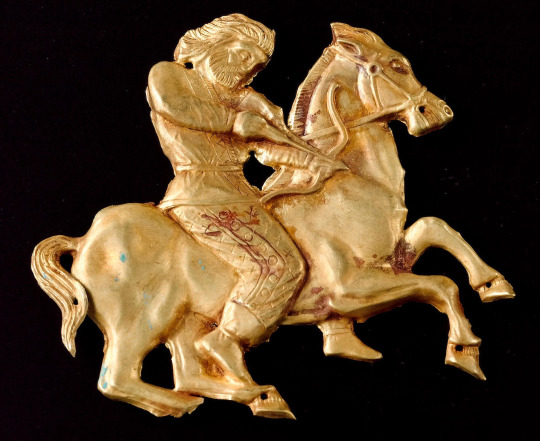
Scythian gold horseman 4th C. BCE. Possibly of Greek manufacture. Boots tied around his ankles, pierced in places for attachment, 1¾in. (4.5cm.), one hoof missing, one bent.
"From the very beginnings of their emergence on the world scene the Scythians took part in the greatest campaigns of their times, defeating such mighty contemporaries as Assyria, Urartu, Babylon, Media and Persia.
The ancient Greek historian Herodotus recorded that Cimmerian tribes had inhabited the Black Sea steppes before the Scythians. Then came the Scythians, and conquered the Cimmerians. Pursued by the Scythians, Cimmerian nomads crossed the Caucasus and spread into the countries of western Asia; and the pursuing Scythians, led over the mountains by their king Madyes, defeated the Medes they found in their path.
Early in the 7th century the Scythians moved against Assyria. The official records of Assyria are highly selective, giving much space to Assyrian victories but remaining silent about Assyrian defeats. Fortunately, a more balanced picture can be built up by comparing various surviving sources - not only the official record, but also the reports of spies, and the questions put by Assyrian kings to oracles when seeking advice.
After a period of warfare between the Scythians and Assyrians the politically skilled Assyrian king Esarhaddon succeeded in winning peace with them, for a time, by the presentation of rich gifts, and by marrying off his daughter to the Scythian king Partatua. The Scythians' attentions were diverted towards Palestine and Egypt. A biblical prophet referred to the Scythians as 'the ancient, mighty people whose language is hard to understand. They are always courageous, and their quivers are like an open grave. They will eat your harvest and bread, they will eat your sons and daughters, they will eat your sheep and oxen, they will eat your grapes and figs.' Only by paying heavy tribute did the Pharaoh Psammetichus I (reigned 663-609) save his country from Scythian invasion.
From Egypt the Scythians returned to Assyria, and in the period c. 650-620 BC Media, one of the richest states of the ancient East, fell steadily under their influence. In 612 BC a Scytho-Median army finally captured Nineveh and overthrew the Assyrian Empire."
-The Scythians 700-300 BC: Dr. E.V. Cernenko, Angus McBride, & Dr. M.V. Gorelik
#scythian#european art#antiquities#sculpture#literature#history#ancient history#pagan#paganism#art#gold art#scythian gold#statue#4th century bce
182 notes
·
View notes
Text
By: Keith Woods
Published: Jul 2, 2023
A look at slavery outside of the West
It has become popular to blame White people for slavery, to the point that many actually believe slavery was invented by or exclusively practiced by Europeans.
But the history of slavery outside the West is far more brutal.

The Arab slave trade emerged in the 7th century, 10 centuries before the Atlantic slave trade
Arabs sold Africans to the Middle East for a variety of jobs such as domestic work or harem guards - castrating male slaves was common, causing over half of males to bleed to death

The Arab slave trade was particularly brutal: it's estimated that 3/4 captured slaves died before they reached the market for sale
Historians estimate that between 10 and 18 million people were enslaved by Arab slave traders, including women and children taken as concubines.
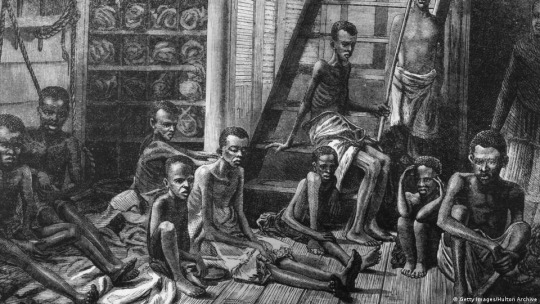
Arabs did not create the slave trade out of nothing, in fact, enslaving conquered tribes was already common practice in Central Africa when they arrived.
The West African Songhai Empire relied heavily on captured slaves in all levels of society, even as soldiers.

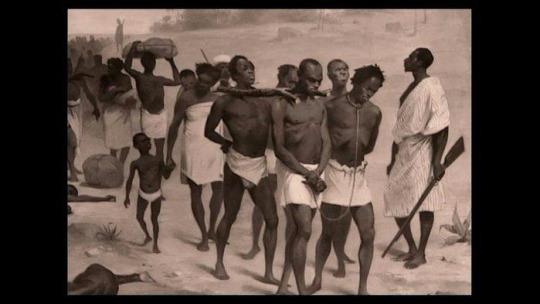
Africans themselves also played a large role in facilitating the trans-Atlantic slave trade.
African tribes conducted raids on rival groups to provide slaves for sale. African middlemen facilitated trade between European traders and African suppliers.



The Arabs also had a slave trade in Europe. Estimates are that up to 1.25 million Europeans were enslaved by Barbary pirates, who would raid villages in coastal countries like Italy, France, England and Ireland, bringing them to North Africa for sale.

In some cases entire villages would be captured, such as the Irish coastal village of Baltimore, entirely raided in 1631.
These slaves faced a brutal future, engaging in hard labour or sexual servitude, and spending nights hot and overcrowded prisons called bagnios.



Many slaves captured by Barbary pirates were sold eastwards into the Ottoman Empire. Slavery was central to the Ottoman Empire, most towns had dedicated slavery markets called Yesirs.
Slaves came from Africa, the Caucasus, the Balkans and Eastern & Southern Europe.

Sexual slavery was a big part of Ottoman society. Slavic women were popular slaves, and Köçeks became a popular source of entertainment in the 19th century:
These were young boys, usually from European backgrounds, who were circumcised, cross-dressed and trained as dancers.


Hereditrary slavery is recorded in China dating back to the Xia Dynasty in 2100 BC. Africans purchased on the Silk Road were used as a sign of wealth.
After Chinese law began to treat women as property around 1000AD it was common to sell daughters and sisters into slavery.
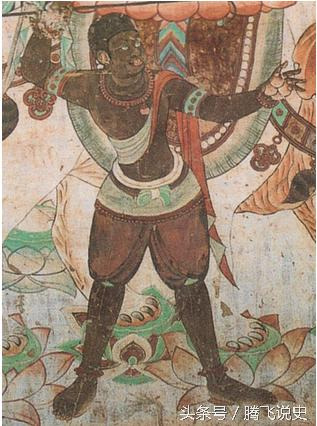

The Mongols enslaves tens of thousands of Chinese as punishment for resistance.
In the post-Mongol Ming Dynasty, thousands of slaves were employed to do bureaucratic jobs for the government, and rich families also employed thousands of slaves to perform menial labour.

Slavery was common in American civilizations like the Aztec and Maya
Among the Aztecs, slavery was a punishment for a variety of crimes or even failure to pay taxes. Husbands and wives sold each other in times of economic hardship. Slaves were identified by wooden collars.
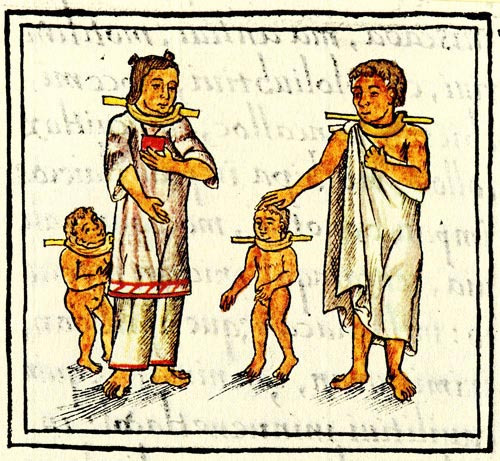
Slavery was also common practice in the civilizations of South-East Asia.
The Khmer Empire had a massive slave class that did much of the work building monuments like Angkor Wat. Historians estimate 25-35% of the population of Thailand/Burma were slaves in the 17th century.
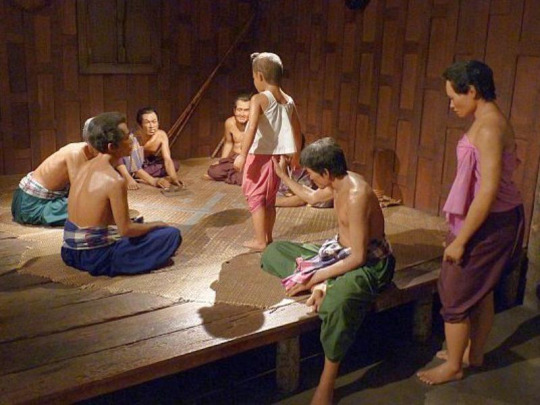

Slavery also existed among Native American tribes. Slavery was common practice among Northwest tribes like the Tlingit, for whom one third of their population during the mid-1800s were slaves.
Various tribes practiced debt-slavery and enslaved captives of other tribes.
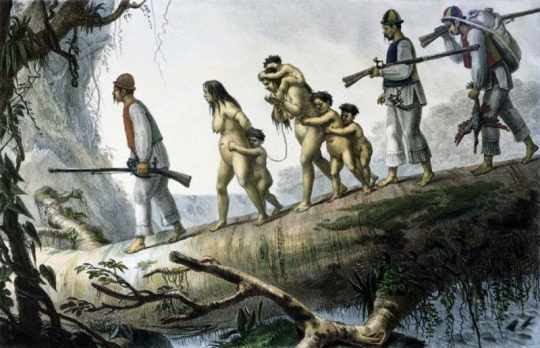

The only difference between these cases of slavery and that practiced by Europeans is that Europeans abolished slavery on humanitarian grounds, and spread this across the globe.
The intense focus on the White role in slavery is a product of widespread Anti-White animus.

==
American exceptionalism comes in two varieties: "we're exceptionally virtuous," and "we're exceptionally evil."
Both rely on lying about or being ignorant of history.
https://www.nationsreportcard.gov/dashboards/schools_dashboard.aspx

And that's just American history. Can you imagine world history?
#Keith Woods#slavery#history#history of slavery#exceptionalism#American exceptionalism#inverted exceptionalism#religion is a mental illness
26 notes
·
View notes